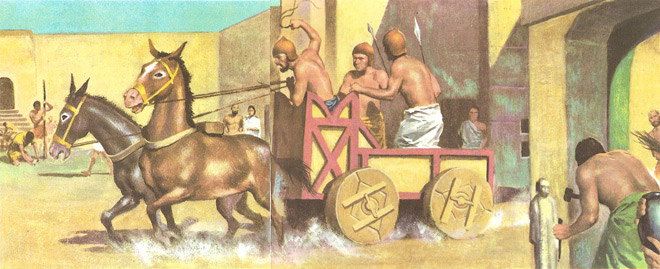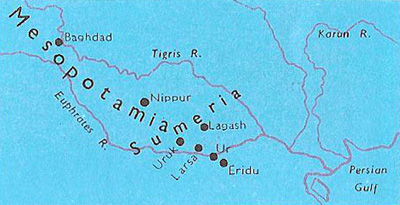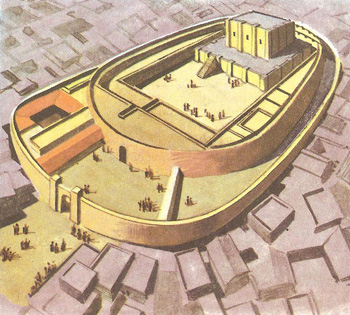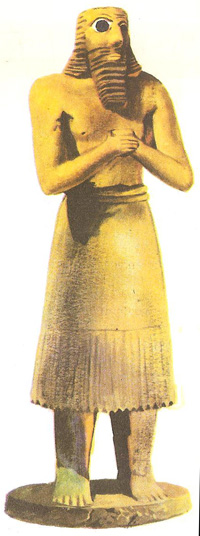Sumerians

In a Sumerian city, near the city wall, a chariot has just passed through the gates carrying soldiers; the wheels are made of solid wood with leather tires.

The larger Sumerian cities.

A large temple built by the Sumerians; note the characteristic oval ground-plan. The city was grouped around the building.
During his 12-year excavation of Ur, the ancient Sumerian city where Abraham was supposedly born, Sir Leonard Wolley made an interesting discovery. He and his colleagues were excavating the palace of a high priestess of the Moon-god Nannar, the patron god of Ur. One room in the palace was full of clay tablets, used for teaching writing, and was clearly part of a school attached to the temple. In the next room the archaeologists found some more clay tablets, part of a statue, a boundary stone, and other objects, lying on a brick pavement of the sixth century BC. These objects were between 700 and 1,600 years older than the pavement on which they lay. They could hardly have been brought together by accident. Then a small clay drum was found, inscribed with four columns of writing. This read: "These are copies of bricks found in the ruins of Ur, the work of Bur-Sin king of Ur, which the Governor of Ur found while searching for the ground-plan of the temple, and which I saw and wrote out for the marvel of beholders." Bur-Sin was king of Ur in 2000 BC; the room was a museum of local antiquities, and the clay drum recorded the first scientific excavation of the city in 600 BC. This story gives us some idea of the antiquity of Sumerian civilization.
The land between two rivers
 |
| Statue of a Sumerian god called Abu
|
Sumer was the ancient name given to the land between the two great rivers, the Tigris and the Euphrates, which flow through Iraq to the Persian Gulf. This land was raised above sea level by the silt carried down the two rivers, and by other, smaller streams. When the marshes were drained, the soil was extremely fertile.
The early Sumerians had no stone for tools, and they had to make their sickles out of dried clay. But there was wood for building ships to sail upstream or across the Persian Gulf, taking traders and their wares to other countries.
By 4000 BC, the early villages of reed huts built round local shrines had grown into towns with populations of several thousand, like Eridu, Uruk, Lagash, and Ur. All kinds of craftsmen lived in these early Sumerian cities, as well as merchants and traders, but the most important people were the priests. The Sumerians were religious people, and paid regular tribute to their gods. The priests looked after the land around shrines, and directed the work carried on in and around the temples. The temples were rebuilt many times, because the Sumerians believed that to repair a temple would bring favor from the gods. Each temple, after serving its time, was filled in with brickwork to become the foundations for the next; so the temple mound, or Ziggurat, grew higher and higher, until it dominated the whole town.
Written records
The Sumerians used clay tablets for writing, and once these were baked, they lasted thousands of years. The earliest tablets have simple pictures and numbers scratched on them. They are accounts kept by priests, lists of cattle, flocks of sheep, wheat, barley, and dairy products, and records of receipts and expenditure. As time went on, these pictures became simplified, until eventually they were only symbols marked in the clay by a reed stylus, or pen. These marks were wedge-shaped or cuneiform, the name given to Sumerian writing.
From about 3000 BC on, the names of kings, or city-governors, begin to appear in the records. They were closely connected with patron gods of cities, and called themselves 'tenant-farmers' of the gods. They were also war leaders, and the victorious king assailing his enemies is a favorite theme in Sumerian art.
Sumerians taught themselves to calculate, beginning with dots stamped on clay. They invented a special symbol for the number 10. They also invented a sun-dial and a water clock for measuring hours, and standards for weights and measures. Wages and rents were paid in barley, but silver and copper were used in exchanging goods.
Sumerian buildings
The daily life of the Sumerians seems to have been very like that of Iraqi peasants today. Their towns, too, must have been similar; the streets were winding, narrow, unpaved lanes; the houses were like those of any small modern Iraqi town except that the Sumerian doorways were usually arched, since there was a shortage of wood for lintels, and the rooms were narrower. Each house was built round a central courtyard on to which all the ground-floor rooms opened. A staircase led to the family's rooms upstairs. The later Sumerians buried their dead in vaults under the paved yard at the back of the house, where there was also a family chapel and alter.
A towering Ziggurat overlooked the Sumerian town, and was the last stronghold of its defense. The city of Ur was fortified by outer walls, inner walls enclosing the Ziggurat. The small shrine at the summit was used chiefly at the great New Year festival, connected with the watering of the land and the fertility of crops. The dazzling procession of priests and leading citizens, the king (taking the part of their god) and his court, would wind its way up the triple staircase to the top of the temple tower. From the summit they would see the smoke of sacrifices rising from distant shrines; then they would offer the ritual sacrifice of living creatures which the gods required.
The Royal cemetery
The discovery in 1926 of a Royal Cemetery, just outside the temple enclosure at Ur, is one of the most thrilling events in the whole history of excavation. The first undisturbed tomb to be found was that of an unknown lady wearing a gold head-dress and holding a gold tumbler to her lips. A magnificent gold dagger and seal belonging to a prince were found in the shaft leading to the tomb, as though they had been thrown down in a farewell gesture. The next tombs discovered were those of a man and a woman, identified by inscribed seals as Abargi and Shubad. They were probably a king and queen of Ur, since they were surrounded by attendants: soldiers wearing copper helmets and carrying spears and daggers, and magnificently dressed court ladies. Each of these attendants had brought with them a little cup of poison which they had taken, sure of continuing to serve their king and queen in another life. There were also animals in the tombs, drawing wagons and chariots, which had been sacrificed so that they too might enter the after-world with their master and mistress. Some of the treasures found in the Royal Cemetery at Ur are on view in the Babylonian Room of the British Museum in London.
